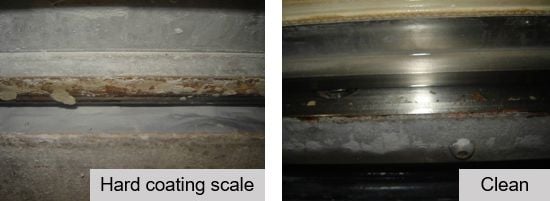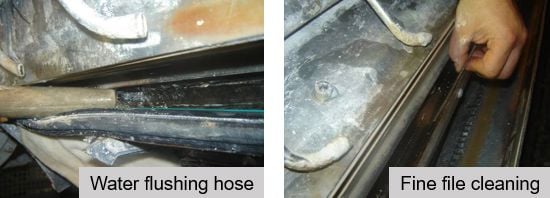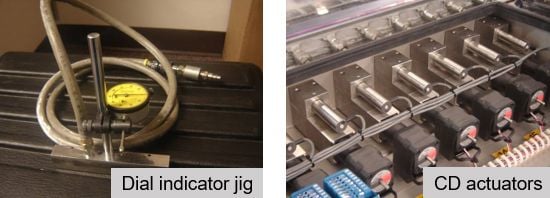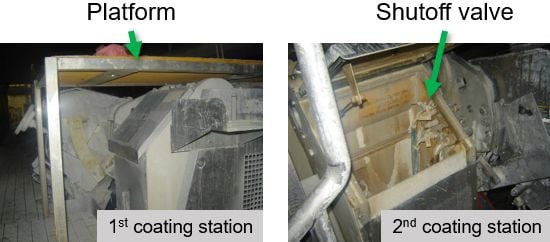Coater service case study - Removing OMC coating buildup
Jul 19, 2022
A U.S. mill was tired of the coating buildup on their on-machine coaters. They called Valmet to assist in cleaning the blade holders, replacing the cross machine coater station profile strips and adjusting a return pan to reduce color leaks.
Blade holder cleaning
One of the most important aspects of good cross direction coat weight control is to have clean blade holders. A blade holder is composed of a stationary holder and a movable holder. Where the two surfaces come together, the coater blade is held tightly to prevent it from coming out during operation.
The movable blade holder also dictates where the coater blade will be in relation to the load tube. As coating builds up on this surface, the blade will be no longer be in correct alignment to the profile strip, requiring the actuators to make more aggressive corrective movements. The pictures shown here illustrate how the scale is built up on the movable blade holder surfaces before and after cleaning. The Valmet coater expert estimated that this buildup was approximately 0.5 – 1.0 mm (500 – 1000 microns).

Buildup on coater blade vs. clean blade
This old coating scale is difficult to remove. Scrapers can only take off the large chunks. Abrasive Scotch Brite pads will take off the next part. Finally, in order to get the last remaining "black" residue off, a fine file is used with water. The Valmet service person left a few of these fine-toothed files for operations personnel to use for cleaning the holders.
A hose inserted into the blade holder on one end of the machine, with a rag pushed into the clamp to form a dam, supplied the water. This worked well for lubricating the files and flushing the scale away. When finished cleaning, all coating deposits were gone and the surfaces were spotless.

Hose on one end flushed water, and fine file removed black residue
Profile strip replacement
The profile strip on OptiBlade coaters is a fiberglass-type material with actuators spaced every 100 mm. The actuators are rigidly connected to the profile strip with a spindle mechanism. On both coater stations, the profiling strips that hold the blade loading tube in place were replaced. Both strips were recalibrated using a dial indicator jig provided by Valmet. Recalibration went well and all actuators were set within 20 microns of each other.

Dial indicator jig for recalibration of profiling strips, and CD actuators
Coater return pan adjustments
The second coater station had been having an ongoing issue with coating loss out of the return pan. Apparently, when the return coating was transferred from the return apron to the pan, some of the coating would miss the pan and fall into the pit. Not only was this a very costly problem, it also created housekeeping problems in the pit.
The Valmet expert determined the pan turning pin was not adjusted correctly. The second coater return pan was moved closer to the return apron approximately 1" by turning the pivot pin flanges 180°.
Blade clamp air supply safety valve
Prior to cleaning the blade clamps, the Valmet expert checked to verify that the air supply valves to them were closed. They were not. Apparently, these weren't part of the multiple lockouts for the coating stations.
For safety, these valves should be closed whenever working in the blade holder area. They should be easily accessible to shut off and/or lock out when working on the blade clamp. To make this shutoff valve easier to get at for the operators, the air supply piping/valves should be moved to the outside of the pivot frame cover door, especially on the first coating station where there is a platform above the door and where the shutoff valves are located (see pictures below).

1st and 2nd coating stations, supply valve and platform
Since it would be more visible, it would be a constant reminder to both the operators and maintenance personnel that it should be closed when working in the blade clamping area.
Recommendations
Based on the inspections completed during the visit, the Valmet coater expert made several recommendations, including:
- Clean the blade holder surfaces down to bare steel during every scheduled maintenance outage to maintain good CD coat weight control and guarantee good clamping operation.
- If coating loss continues on the C2 coater return pan, consider bending the return apron out more and/or unscrew the pan turning cylinder clevis.
- Relocate the air supply shutoff valves for blade clamps to a more convenient and visible location.
Coater Process and Condition Test
Coating process reliability and runnability are ensured by periodic maintenance of the coating station. This includes various actions in response to the tests and inspections to improve the performance of coating station equipment. Regular service of your on- or off-machine coaters should include checkups by a Valmet coater expert.
Contact your Valmet representative to have your coaters audited today.